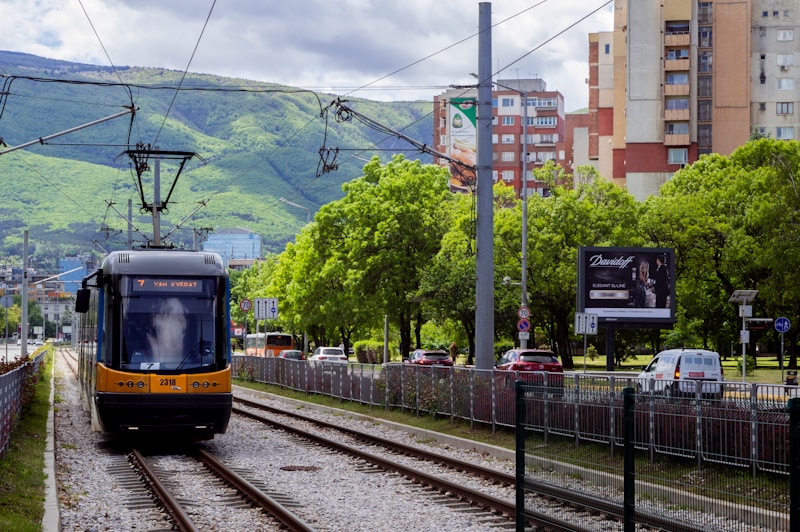9 Questions
What was the first successful commercially steam locomotive?
Which country had the first electrified high-speed rail?
Who developed the first direct current electrical control system for diesel-electric locomotives?
What was the first main-line three-phase locomotive?
What was the first railway in Cuba?
What was the first railway in Spain?
What was the first railway in Japan?
What was the first Canadian railway?
What was the first passenger tram?
Summary
A Brief History of Rail Transport
-
Rail transport dates back to around 3838 BC with the construction of the Post Track, a prehistoric causeway in England.
-
The Diolkos paved trackway in Greece was in use for over 650 years, transporting boats across the Isthmus of Corinth from around 600 BC.
-
Wooden rails and horse-drawn traffic wagonways were used in Europe and England in the 1550s to transport ore tubs to and from mines.
-
The first steam locomotive was built in 1804 by Richard Trevithick in the UK, and the first commercially successful steam locomotive was Matthew Murray's rack locomotive Salamanca built for the Middleton Railway in Leeds in 1812.
-
George Stephenson built the Rocket in 1829, which won the Rainhill Trials and established his company as the pre-eminent builder of steam locomotives.
-
Steam power continued to be the dominant power system in railways worldwide for over a century.
-
The first electric locomotive was built in 1837 by Robert Davidson of Scotland, powered by galvanic cells (batteries), but limited power prevented its general use.
-
Early experimentation with railway electrification was undertaken by Fyodor Pirotsky in 1875, and the Siemens brothers began commercial production of their own design of electric trams in 1881.
-
The first use of electrification on a mainline was on a four-mile stretch of the Baltimore Belt Line of the Baltimore and Ohio Railroad in 1895.
-
Electricity became the power supply of choice for subways, aided by the invention of multiple-unit train control in 1897.
-
Steel rails replaced iron, becoming standard for all railways.
-
The introduction of the Bessemer process, enabling steel to be made inexpensively, led to the era of great expansion of railways that began in the late 1860s.A Brief History of Railway Technology
-
Three-phase AC power transmission was demonstrated in 1891, leading to the development of three-phase motors for electric locomotives.
-
Kálmán Kandó developed the first 3-phase asynchronous electric drive motors and generators for electric locomotives in 1894, which were used in the Lugano Tramway.
-
The first main-line three-phase locomotives were supplied by Brown and Boveri in 1899 in Switzerland.
-
Italian railways introduced electric traction for the entire length of a main line in 1902, using a three-phase electrical system at 3 kV 15 Hz.
-
SNCF of France established 50 Hz as a standard for main lines after successful trials in the mid-20th century.
-
Diesel-powered locomotives were first produced in 1906 by Rudolf Diesel, Adolf Klose, and Gebrüder Sulzer.
-
Hermann Lemp developed a reliable direct current electrical control system for diesel-electric locomotives in 1914.
-
The first regular use of diesel-electric locomotives was in switching (shunter) applications, with General Electric producing several small switching locomotives in the 1930s.
-
The Canadian National Railways were the first North American railway to use diesels in mainline service in 1929.
-
The first electrified high-speed rail was introduced in Japan in 1964, with subsequent systems built in other countries including Spain, France, Germany, and the United Kingdom.
-
Alstom Coradia Lint hydrogen-powered trains were introduced in Lower Saxony, Germany in 2018.
-
The earliest railway in Britain was a wagonway system used by German miners in the 1560s, and the first passenger tram was opened in Wales in 1807. The Stockton and Darlington Railway in England was the first public railway to combine locomotive power, malleable iron rails, twin tracks, and other innovations in 1825. The Liverpool and Manchester Railway was the first modern railway, with both goods and passenger traffic operated by scheduled locomotive-hauled trains in 1830.The Impact of Railways on Society: A Historical Overview
-
Railways revolutionized transportation and were essential to industrialization.
-
The Bury Pattern was popular for passenger locomotives, while the Long Boiler design became a standard for goods engines.
-
The railways reduced transaction costs, lowered the costs of goods, and gave rise to greater variety in people's diets.
-
Rail transport improved personal mobility, leading to an extremely rapid expansion in passenger services.
-
The Metropolitan Railway was the world's first "Metro," connecting several railway terminals in London.
-
Railways provided a significant stimulus to the coal-mining, iron-production, engineering, and construction industries.
-
Germany imported their engineering and hardware from Britain but quickly became self-sufficient in meeting the demands of railroad construction, stimulating the growth of the new steel industry.
-
The freight trains in France were shorter and less heavily loaded than those in rapidly industrializing nations such as Britain, Belgium, or Germany.
-
The first line to be built on the Italian peninsula was the Naples–Portici line in 1839.
-
The first Canadian railway, the Champlain and St. Lawrence Railroad, was opened in 1836 outside of Montreal.
-
The railways in Spain began in 1848 with the construction of a railway line between Barcelona and Mataró.
-
Cuba, then a Spanish colony, built its first rail line in 1837.The History and Development of Railways in North America, Latin America, Asia, and Africa
North America:
- Railways played a major role in the development of the United States, linking every city by 1860.
- The South built short lines linking cotton regions to ports, whereas the North and Midwest constructed networks.
- Over 80% of farms in the heavily settled Midwestern Corn Belt were within 10 miles of a railway, facilitating the shipment of goods.
- By 1890, the national rail system was virtually complete with 164,000 miles of track.
- Transcontinental railways were built to the West Coast, but the system was too expensive and the government took over the lines.
- The railways were essential to the growth of wheat regions in the Prairies and to the expansion of coal mining, lumbering, and paper-making.
Latin America:
- Railways were critical in the early stages of modernizing the Latin American economy, linking agricultural regions to export-oriented seaports.
- After 1870, Latin American governments encouraged rail development through generous concessions that included government subsidies for construction.
- By 1900, Argentina, Brazil, and Mexico were the leaders in length of track in service.
Asia:
India:
- The first train in India ran from Red Hills to Chintadripet bridge in Madras in 1837.
- The first passenger train in India ran between Bombay and Thane in 1853.
- In 1872, the first railway in Japan was inaugurated by Japanese Government Railways, connecting Shimbashi in Tokyo and Yokohama.
- In 1964, the first electric high-speed rail in the world, Tōkaidō Shinkansen, was inaugurated by Japanese National Railways, connecting Tokyo and Osaka.
Pakistan:
- Rail transport is a popular mode of non-independent transport in Pakistan.
Africa:
- The railway was built from the Kenyan port of Mombasa to Kampala, Uganda, and construction was hampered by the presence of man-eating lions.
Description
How much do you know about the fascinating history and development of railways across the world? Test your knowledge with our quiz! From the early use of wooden rails to the introduction of steam locomotives and the electrification of railways, this quiz covers everything from the origins of rail transport to its impact on society. You'll also learn about the development of railways in North America, Latin America, Asia, and Africa. Take this quiz and see if you're a true rail transport expert!


